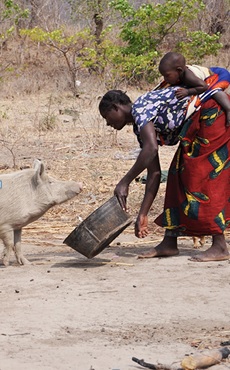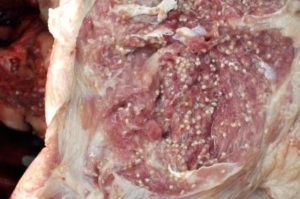
The pork tapeworm – Taenia solium – is an extra-ordinary zoonotic parasite which has considerable impact on human and animal health as well as on the agricultural and health sectors in many low income countries. T. solium infection begins with the consumption of raw or undercooked infected pork.
In humans, the adult stage of the tapeworm is found in the intestines (taeniasis) and the larval stage can develop as cysts mainly in the subcutaneous tissue, skeletal and heart muscles (cysticercosis), and most scaring, in the brain – a condition called neurocysticercosis.
 Tapeworm cysts in the brain very often remain without symptoms for several years. The exact host-parasite interactions that finally, but not necessarily, lead to severe neurologic signs like epileptic seizures are still intensively discussed in the scientific community. But what we all agree on is that the immune system of the host plays a major role in the progress and presentation of neurocysticercosis.
Tapeworm cysts in the brain very often remain without symptoms for several years. The exact host-parasite interactions that finally, but not necessarily, lead to severe neurologic signs like epileptic seizures are still intensively discussed in the scientific community. But what we all agree on is that the immune system of the host plays a major role in the progress and presentation of neurocysticercosis.
These observations and articles gave rise to many questions in our research group. Does chronic suppression of the human immune system – like the human immune deficiency virus (HIV) – lead to a higher infection rate of the pork tapeworm in individuals?
Also, are symptoms of individuals infected with both diseases the same or different with individuals infected only with neurocysticercosis – requiring maybe different treatment? Or can this immune suppression even “protect” individuals with tapeworm cysts in the brain? There is strong evidence that symptoms are related to the attack of the parasite by human immune cells causing massive local inflammation.
Furthermore, we found that so far only little clinical research was published in regards to neurocysticercosis and HIV; a precise case-control approach was totally lacking. Around 2011, we decided to further investigate these pending questions in an African country well known to be prevalent for both diseases – Tanzania.
A year later I spent several months in a remote missionary hospital in Northern Tanzania to investigate, together with a large medical team, a group of 170 HIV- infected individuals for the presence neurocysticercosis. We used questionnaires, neurological examination, several serological tests, and – most challenging due to frequent power cuts – computed tomography.

In parallel, nearly every day a medical field team drove to the remote villages where our HIV patients came from to search for HIV negative controls. By examining these controls with the same diagnostic tests, we hoped to answer some of the pending co-morbidity questions.
Finally, in our study, published in Infectious Diseases of Poverty, we were able to demonstrate the relevance of T. solium infections in the Northern parts of Tanzania and describe in detail the clinical presentation of identified neurocysticercosis cases. However, there was no evidence that T. solium infection is more frequent or presented differently in individuals with and without HIV.
It has to be considered that our study had several limitations due to financial restrictions and that the gap of this co-morbidity is still wide. Therefore, future research activities should be conducted using larger sample sizes, more recently diagnosed AIDS cases etc. to fully answer pending questions of neurocysticercosis in the context of HIV/AIDS.
After reading this article one should be careful for eating pork meat.
Thanks a lot for your this very great work.Am impressed